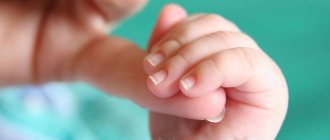Moms and dads can't wait for their children to stand on their feet and take their first steps. However, such a joyful event is often overshadowed if parents notice that the baby begins to walk like a ballerina.
Why does a child stand on his toes, can this phenomenon be considered a norm or a violation? Experts are sure that the correct answer depends on how often your child behaves this way. Sometimes this behavior is not a symptom of a disease.
The funny gait is quite common among young children. The baby may be 10 months old, one or two years old - sometimes or constantly he walks on tiptoes.
At first, this method of movement causes affection among relatives, but a little later they begin to worry and worry whether everything is okay with the baby.
In any case, if the child does not step on the entire foot when walking, the true reasons for this phenomenon should be found out.
When is it normal for children to walk on their toes?
Age
If a one-year-old child walks on his toes, this is not a reason to run to a neurologist for medicine or an orthopedist for “special” shoes. The development of gait is formed in children under 2 years of age, so it is not advisable to consult a doctor before this age.
In the period from 2 to 3 years, such a manifestation is also considered acceptable if there are no other abnormalities and your pediatrician sees no reason for concern. When a three-year-old child walks on his toes, it will not be superfluous to contact a specialist in order to find out the reason in time and begin correction, if necessary.
Only complaint
If your baby walks on his toes and no other abnormalities are noticed, exhale. Serious diseases, which we are all internally afraid of, have a number of additional symptoms in addition to this.
Both legs at the same time
It is considered normal if a child walks on tiptoes (the reason may not be determined) and always uses both legs equally in the process. That is, you do not see obvious distortions and different insteps in the gait.
Does not affect coordination
This form of toe walking, which is not hazardous to health, will not affect the child’s coordination of movements. Limping and other obvious abnormalities that make your gait strange are a reason to see a doctor.
Episodicity
When a child begins to walk on his toes, what should parents do? Correct answer: observe. If the baby does this temporarily, occasionally, and at the same time retains the ability to walk with support on the entire foot, then this is also a variant of the norm.
Putting a child to sleep: when, how, on what
There is also no need to force a newborn baby to sleep: he himself knows “when it’s time for him.” Again, your task is to track this moment (rubs his eyes, tugs at his ears, begins to act up) and be ready to provide him with such an opportunity. A newborn sleeps for 3-4 hours straight, after which he eats and sleeps again. This is how the first or third month passes: the baby sleeps 16-20 hours a day. Gradually, sleep time decreases and wakefulness increases. And at 6 months, the baby sleeps only 14.5 hours a day, of which 3-4 naps during the day.
But the question of what and where to sleep is worth attention and care on your part. For the first 2-3 months, the baby can sleep in his stroller, if there is a sufficiently hard and flat surface there. Then he can go to his crib or join his parents (if he ends up in their bed at least once). So that the baby can sleep in both the nursery and the shared bed: the choice is up to the parents. The requirements remain: a flat, fairly hard surface, the absence of a pillow (it is replaced by a sheet folded in four), free air movement (for this reason, it is better not to buy all sorts of canopies for a children’s bed).
Regarding the room in which the newborn is located, it is worth pointing out that it should be sufficiently light, ventilated every 4 hours for 15-20 minutes, the air temperature in it should be 19-22 degrees, humidity 50-70%. At first, wet cleaning should be done daily.
The child began to walk on his toes: reasons for the deviation
Why do children walk on their toes for no apparent reason? They just love it! The child has mastered a new skill and gets involved, and if at the same time he notices increased attention from adults, then he will practice even more often.
For cases where the reason why a small child walks on tiptoes is not clear, there is the term idiopathic walking. It is often observed in children whose parents or relatives also walked on toes in childhood, that is, it is completely inherited. It does not require special correction or treatment; it goes away on its own with age without treatment, unless, of course, other abnormalities are identified.
Another harmless option for why children walk on tiptoes is because they get taller. This means they can see something interesting and reach for something forbidden.
And in general, this is such a moment of imitation: for example, a child feels big, like his dad, or imitates his mother who walks in heels like that. Therefore, before causing a panic like “why does a small child walk on his toes, and not as expected?”, let the baby calmly explore the capabilities of his body and gait, guide him, but do not frighten him or scold him.
It happens that a child walks on tiptoes, there is no reason for this at first glance, but later it turns out that everything is simple - the baby is uncomfortable. The catalyst may be a floor that is too cold or dirty and sticky. It happens that a child remembers how painful it was to stand on something or slightly injured his foot and therefore automatically rises on his toes.
Nail care
In addition, it is worth paying attention to the child’s nails: they are cut 1-2 times a week. For this, ordinary nail scissors are best suited (no modern children's scissors fit so perfectly). But they should be intended only for newborns! Nails on the hands grow faster than on the legs. It is necessary to monitor their growth, since the baby is capable of scratching himself with his uncoordinated hands and fingers. Even if you put scratches on him, chances are he will take them off easily. The nails on the hands are cut in the shape of a finger (oval), and on the legs straight.
Why do children walk on their toes? Provoking factors
- Using a walker. In them, the child often stands on his toes, and therefore continues to use this manner of walking.
- Hyperactivity, temperament, stress. In general, anything that throws the baby’s nervous system out of balance can serve as an impetus for the child to start walking on tiptoes.
- Premature babies experience periventricular leukomalacia, a lesion of the white matter of the cerebral hemispheres that can cause problems with coordination and motor functions, including walking on their toes.
- Shortening of the Achilles tendon or calf muscles, inflammation of the heel bone and other changes in the foot cause discomfort for the child and force him to rise on tiptoes when walking. Only a doctor can diagnose the disorder and prescribe treatment.
- When a child walks on his toes, parents should rule out neurological spectrum disorders: autism, cerebral palsy, since such a symptom occurs with these diagnoses. But pyramidal insufficiency syndrome (a disruption of the part of the nervous system responsible for movement) is considered by doctors of evidence-based medicine to be a diagnosis for anxious mothers, but not a disease requiring treatment.
Physical education lessons for two-year-olds
If the child continues to walk on his toes, even after two years, then treatment continues. In this case, it is recommended to engage in feasible physical activity with your child:
- Running up the stairs strengthens the calf muscles and relieves tightness.
- Climbing slides and Swedish stairs develops the muscular skeleton and helps reduce tone.
- Jumping on a trampoline helps develop coordination and also relieves muscle tension.
- Walking along “healing paths”. You can lay out a path in the room, which consists of pebbles, a rug, sewn buttons and other items.
- It is useful to roll a gymnastic stick with your toes.
- Walking sideways, backwards and in waves amuses the baby and develops a sense of balance.
You can purchase a massage mat and place it in front of the entrance to the children's room. So, every time the baby enters the room, he receives an involuntary massage.
A child walks on his toes: what to do?
Doctors believe that up to 3 years of age, due to the heavy load when walking and the strong development of the ankle muscles, children can move like this and not have any deviations.
In the West, if a child walks on tiptoes but is otherwise healthy, doctors do not consider this a pathology until the age of 6.
However, even if there are no dangerous reasons why a child constantly walks on his toes, from the age of 3 it is worth devoting time to activities aimed at maintaining the normal formation of the foot. After all, such a harmless habit can negatively affect the natural development of the baby’s growing legs.
What should you do if your child walks on tiptoes, first of all? Buy ortho-mats and place them in the area where the baby spends most of his time every day. Try swimming and massage, rolling various objects with your feet and exercise therapy complexes.
If such therapy does not have an effect after a while, you suspect that in this particular case, walking on toes is not normal, then you need to consult a pediatrician, as well as a neurologist and orthopedist.
Pathological causes
Most often, the provoking factor for ballet gait is oxygen starvation of the fetus during pregnancy or childbirth. As a result, the child experiences muscle hypertonicity.
Let's list a few more possible reasons.
- With muscular dystonia, the tension is unevenly distributed: in one part of the foot it is increased, and in the other it is decreased. Because of this, the weight on the foot is distributed incorrectly.
- Sometimes a pathology such as cerebral palsy manifests itself in seemingly harmless toe walking.
- Birth injuries as a result of a difficult birth or complications that arose during obstetrics.
In any case, only doctors can establish an accurate diagnosis or recognize the harmlessness of this method of movement.
A pediatrician or neurologist will assess whether there is a delay in the formation of the motor system, determine the causes of the disease and prescribe a course of treatment.
Adults will receive qualified recommendations and learn what needs to be done to treat a child, for example, how to perform a massage at home.
If a child walks on his toes: what to do and how to treat
First of all, conservative treatment is used, which includes:
- walking barefoot on uneven surfaces;
- massotherapy;
- swimming with a coach;
- various types of walking: in a half-squat, single file, on the heels, on the inner and outer sides of the foot;
- climbing;
- cycling (pedaling) for older children.
If these activities do not help and the child walks on tiptoes, the doctor must decide what to do next. Depending on the situation, the problem will be dealt with either by a neurologist, selecting special medications and therapy, or by an orthopedic surgeon, who, in the absence of positive dynamics and taking into account the diagnosis, may recommend surgical intervention.
Let’s summarize for those whose baby walks on tiptoes. What to do? To begin with, up to 2-3 years of age, leave them alone and do not scold them, reduce the degree of attention and observe from the sidelines, if there are no other health problems.
The child began to walk on his toes spontaneously, he is over 3 years old, are there any other complaints about development and well-being? This is already a good reason to contact a specialist without delay.
Remember that “terrible” diagnoses always have a number of other symptoms, in addition to tiptoeing, so you are unlikely to miss them, and excessive control and care are not good for either the baby or the mother.
Children's orthopedist Kirill Shlykov told how a child's foot should develop, whether children need orthopedic shoes, and what is the correct way to wear them at home.
- share with your friends!
Follow us on Facebook:
When should a tiptoe walker be seen by a doctor?
Doctors usually recommend contacting pediatricians, neurologists and orthopedists if idiopathic tiptoeing persists and continues for more than three years. In this case, the doctor should evaluate the child's gross and fine motor development and determine whether tiptoeing has damaged the Achilles tendons and calf muscles.
If the doctor notices that tiptoeing is harmful to the health and development of the child, he may recommend a course of physical therapy, prescribe exercises and massage, and, in extreme cases, refer the child for surgery.
In addition, if other neurological syndromes are observed, a diagnosis is carried out to exclude autism and cerebral palsy.








